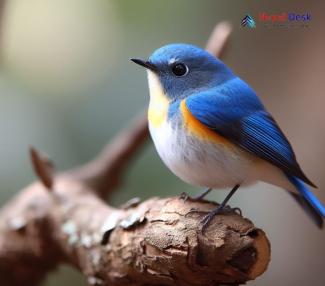Nestled in the heart of the beautiful Himalayas, specifically in Nepal, resides a small yet captivating bird species known as the Himalayan Bluetail (Tarsiger rufilatus). This exquisite creature boasts a striking blue coat with complementary chestnut accents, garnering admiration from bird enthusiasts and curious travelers alike. In this article, we'll delve deeper into the details surrounding this unique bird species, explore its presence in Nepal, and uncover some fascinating tidbits that make it worthy of attention.
Species Detail: A Glimpse into the Life of Himalayan Bluetail
The Himalayan Bluetail is a small passerine bird species belonging to the Old World flycatcher family (Muscicapidae). Measuring around 14 centimeters in length, these petite birds display sexual dimorphism – that is, males and females exhibit distinct physical appearances. While the male Bluetails boast an unmissable bright azure plumage mixed with chestnut hues on their upperparts, female counterparts flaunt more muted colors ranging from brownish-grey to mousy chestnut tones.
These captivating birds predominantly feed on insects and occasionally fruit or seeds. As expert foragers, they use their skillful techniques to scour for food both on ground level and within tall trees. During breeding season which typically occurs between April and July, the males' melodic songs help attract mates and stake out territory.
Presence in Nepal: Exploring the Himalayan Bluetail's Habitat
While their range spreads across various parts of Asia – including Bhutan, India, Myanmar, China, and Vietnam – Nepal is one country where they thrive extensively. In Nepal, they can primarily be found at elevations of 2,000 to 3,600 meters amidst mixed coniferous forests, thickets, and rhododendron scrubs. Frequent trekking enthusiasts in areas such as Annapurna, Langtang, and the Everest regions may be in for a delightful sighting of these bright birds.
Interestingly, while the Himalayan Bluetail is a resident species in its higher-altitude habitats like Nepal, it's also known to be partly migratory. This means that during harsh winter months, the birds may descend to lower elevations spanning from 1,000 to 2,500 meters for better survival opportunities.
Captivating Facts: What Makes Himalayan Bluetail Special
Despite their small size and seemingly simple lifestyle, Himalayan Bluetails host an array of remarkable traits that make them a fascinating species to study. For instance, when catching insects, they employ a unique 'flutter-chase' method involving flying in a rapid flutter-like motion towards their prey before skillfully grabbing them mid-air. Additionally, not only are their songs melodious and enchanting but also impressive in variety. A single male bluetail may incorporate numerous elements into his avian symphony, treating keen listeners to a complex auditory experience.
In conclusion, the Himalayan Bluetail is undeniably an enchanting bird species that further enhances the richness and diversity of Nepal's exquisite natural beauty. Now equipped with better knowledge about this charming bird's details, habitat preferences, and interesting quirks, we invite you to keep an eye out for brilliant flashes of blue on your next Himalayan adventure – you might just be fortunate enough to spot one of these incredible creatures.




